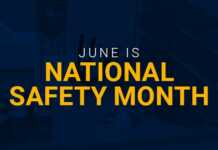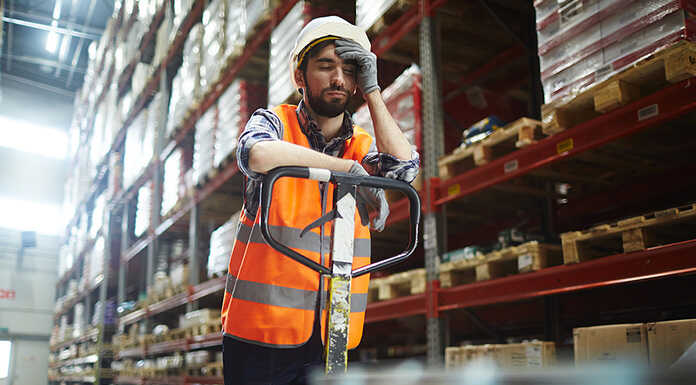Not too long ago, a new ICW Group workers’ compensation policyholder asked me to provide fall prevention and ladder safety training to their three maintenance crews. During the first training with twelve employees, I explained my role as their assigned Risk Management Consultant and let the group know the training would last about 45 minutes. During my introduction, I noticed one individual looked very tired. It was 10 a.m., and the crew had just started their day.
About 10 minutes into the meeting, the individual in question stood up. I continued talking about basic ladder safety and kept an eye on the individual. And then it happened. Suddenly the individual stumbled forward and caught himself before he fell face forward onto the ground. Now granted, I might not be the most intriguing public speaker around, but I think I’ve yet to put a crowd spontaneously to sleep. The gentleman falling forward was startled, along with myself and everyone in the room.
I decided to change gears. I asked the attendees the following question: How many of you slept eight hours or more last night? Looking confused and dumbfounded, two employees (15% of those present) shyly raised their hands. I then asked how many slept seven hours, and three (25%) individuals, including myself, raised their hands. I asked how many slept six hours, and four (30%) raised their hands. Three individuals (25%) raised their hands when asked how many slept five hours. Finally, I asked how many slept four hours, and the one gentleman (5%) who had dozed off admitted to having only slept four hours the night before.
A Sleep-Deprived Workforce
Fatigue in the workplace puts a great risk on the business. According to National Safety Council (NSC) statistics, 37% of employees are sleep-deprived. In my training group, the number was much higher. Sleep deprivation is defined as not getting enough sleep. For most adults, the amount of sleep needed for their best health is between 7 to 8 hours.
Indeed, fatigue in the workplace can be deadly. According to the National Safety Council, 13% of work-related injuries can be attributed to lack of sleep. Moreover, 20% of all auto accidents are suspected to be tied to fatigue or lack of sleep. Indeed, two-thirds of U.S. Workers report having felt fatigued at work.
What is fatigue? Fatigue is feeling tired, sleepy, lacking energy, and needing extra effort to perform routine tasks. Losing two hours of sleep can have similar effects to drinking three beers. Seventeen hours of lack of sleep is similar to a blood alcohol content of .05; lack of sleep for twenty-one hours is similar to a blood alcohol content of .08; and twenty-four hours without sleep is similar to a blood alcohol content of .10.
Consequences of Fatigue
According to the NSC, fatigued employees are three times more likely to have an automobile accident. Employees doing shift work or overnight shifts are at higher risk of not sleeping well than employees working day shifts. In a UCLA Health study, night shift workers get a daily average of two to four hours less sleep than day shift workers. It is tough for our bodies to adjust to sleep during the day.
Night shift workers are 30% more at risk of having a work-related injury than day shift workers. Workplace accidents are more prone to occur between 2 a.m. to 6 a.m. According to the Journal of Occupational Health, April 2021, men and young adults have higher incidents of injuries related to fatigue, and most serious accidents occur between the 5th and 8th hours of a shift.
Chronic fatigue is more common in the age group between 40-60 years of age and is more common among women. The effects of chronic fatigue can be a reduction of attention and memory. Employees suffering from fatigue are more likely to make errors, make poor decisions, and take risks. Fatigued employees are less likely to be communicative and can suffer reduced memory, resulting in forgetting safe work practices and work instructions, and reduced attention to detail. Moreover, reaction time is also reduced, and error rates go up, increasing the possibility of incidents and injuries. Working more than 50 hours per week almost doubles the risk of error.
According to Federal OSHA, workplace fatigue is linked to health problems such as heart disease, stomach, and digestive issues, musculoskeletal disorders, reproductive problems, depression, sleep disorders, obesity, and the worsening of chronic diseases such as diabetes and epilepsy.
According to the National Safety Council, sadly, only 20% of employees recognize fatigue as a risk factor or a hazard. Many employees tend to underestimate their fatigue factors and not view their fatigue as a safety factor.
Protect Against Work Fatigue
How can employees protect themselves from the effects of worker fatigue and decrease their risk of injury?
- Get sufficient sleep. Nothing replaces sleep better than sleep.
- Maintain a regular schedule of sleep.
- Avoid the temptation to stay up late on the weekends and stick to your regular sleeping schedule.
- Avoid eating meals and heavy snacks before going to bed to avoid the possibility of stomach acid or difficulty sleeping.
- Minimize the use of caffeine-containing products.
- Turn off electronic devices such as cell phones and laptops at least one hour before bedtime.
- Regular exercise also helps to establish a regular sleep pattern, but not close to bedtime.
- Maintain a dark and fresh bedroom in which to sleep.
- Avoid having your bedroom serve as your home office whenever possible.
To quote Shakespeare- “Sleep the main course in life’s feast, and the most nourishing.” Please, friends, get adequate sleep before your work shift, so you go home safe.

















